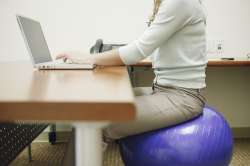How to burn calories even when you sit at a desk all day
Continuous movement while sitting may increase metabolic rate more than standing at a desk.

Being desk-bound at your 9-to-5 (ugh, more like 9-to-7) can set up a series of weight-loss hurdles. Your typing fingers are the only part of your body actually getting a workout and mindless snacking at your desk under the glow of fluorescent lights isn’t exactly helping to whittle your waistline. Sitting at your desk all day can wreak havoc on your body.
However, continuous movement while sitting may increase metabolic rate more than standing at a desk, suggests a study.
Craig Horswill, clinical associate professor of kinesiology and nutrition at the University of Illinois at Chicago, says the study adds to the growing body of evidence that suggests strategies for increasing non-exercise active thermogenesis-defined as spontaneous activity unrelated to a fitness routine-are needed to help overcome the detrimental effects of prolonged sitting.
Sitting has been identified as a risk factor for early mortality, independent of the presence of a disease, such as cancer or diabetes. Up to 7 percent of deaths have been attributed to sitting alone.
"Sitting is bad for our health, but it is a big part of daily life for many people," said Horswill, an expert in exercise and metabolism in UIC's College of Applied Health Sciences. "Exercise is a good way to counteract the negative effects of sitting, but just incorporating physical activity into one part of our day may not be enough to overcome the damage caused by prolonged sitting and an otherwise sedentary lifestyle."
Because the workday is a major contributor to sedentary behavior, tactics that promote workstation activity have emerged in recent years, including standing desks, as well as dynamic pedal and treadmill workstations.
Horswill and his colleagues compared the metabolic rate produced by three workstations: seated at a desk, seated at a desk equipped with a device that stimulates leg movement and standing at a desk. The device, which is commercially available, was a movable footrest, suspended from the underside of the desk, which enabled the feet to swing, twist or teeter.
Participants in the study familiarized themselves with the workstations during one visit. On a second visit, researchers collected metabolic rate and heart rate data during three progressive stages: seated, seated with the device and standing. Each stage was 15 minutes.
The researchers found that modest movement while seated elevated the metabolic rate more than sitting and more than standing, by 17 and 7 percent respectively, and had no detrimental effect on cognitive function.
"These results suggest that non-exercise active thermogenesis, which we call NEAT, can increase movement and calorie burning, and may have the potential to impact health," said Horswill, the senior author on the study.
"We expected to see the metabolic rate increase with each progressive stage, but instead found that metabolic rates from movement while seated were either equal to or higher than rates while standing."
The findings are published in the journal Work.
(with ANI inputs)